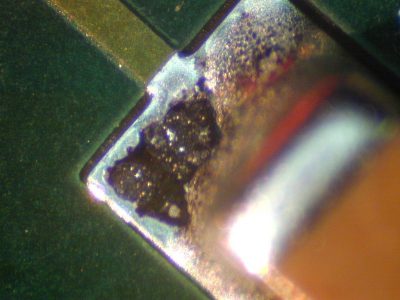
Black Tar was first seen during the introduction of lead-free technology but also seen with tin/lead on selective and wave soldering process particularly on through hole parts. However, as show in the example above it has also been seen on surface mount parts that are wave soldered. The x-ray image shows poor wetting to the surface of the pad and also in the barrel of the through hole joints. “Black Tar” was a term coined my two engineers in the UK Price/Willis as the deposit looked more like a soft deposit and a surface plating issue
Black Tar has not been seen or certainly reported since PCBs suppliers have look closely at the controls placed on the nickel plating process as this was seen to be causing the problem. Assembly engineers need to understand and look at the controls recommended by chemistry suppliers, use this as a guide when auditing your PCB producer. Many engineers associated this defect with black pad for obvious reasons due to the colour. However the visual appearances on the surface of the nickel with each of these issues were different. Even though the solder joint in selected areas around the pad edges was affected the mechanical strength of the solder joints in shear or pull testing did not appear to decrease. This is not the case with black pad which did impact the joint strength
National Physical Laboratory, NPL, has created an interactive assembly and soldering defect database, each month readers can add other defect solution to their own collection. Also available from the database is free access to over 100 process and reliability reports on soldering technology, Download Here
See more faults by the author on our YouTube Video Channel
To complement our “Defect of the Month” editorial Circuits Assembly now features “Defect Video of the Month” presented online by Bob Willis. This covers different failure modes with many video examples of defect occurring in real time and supported by IPC


